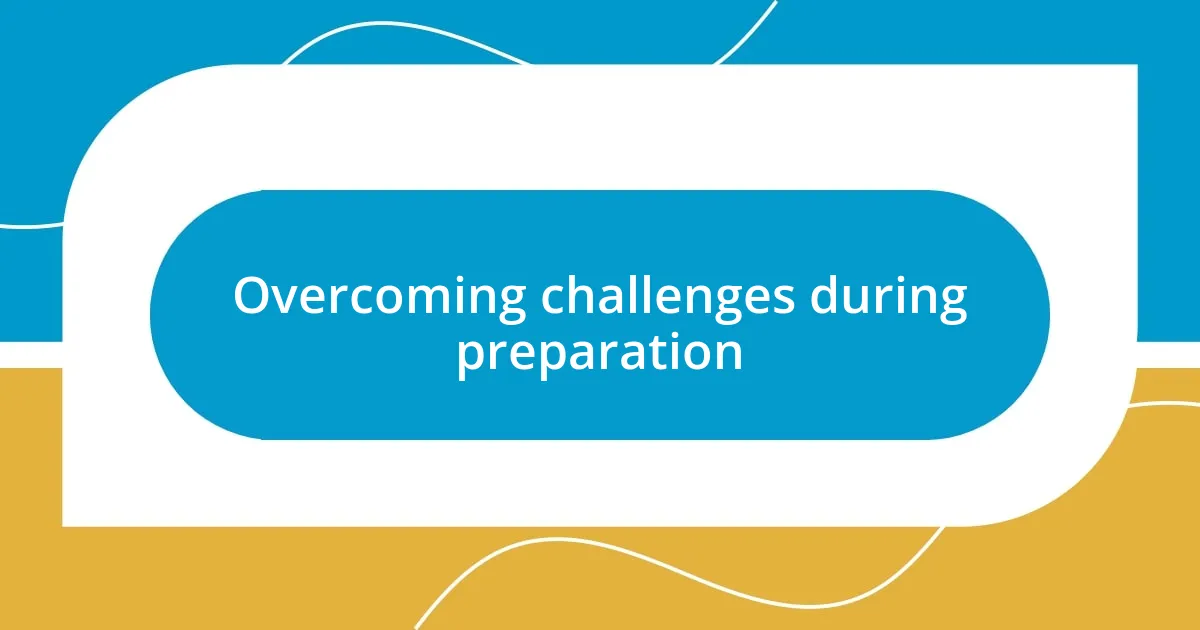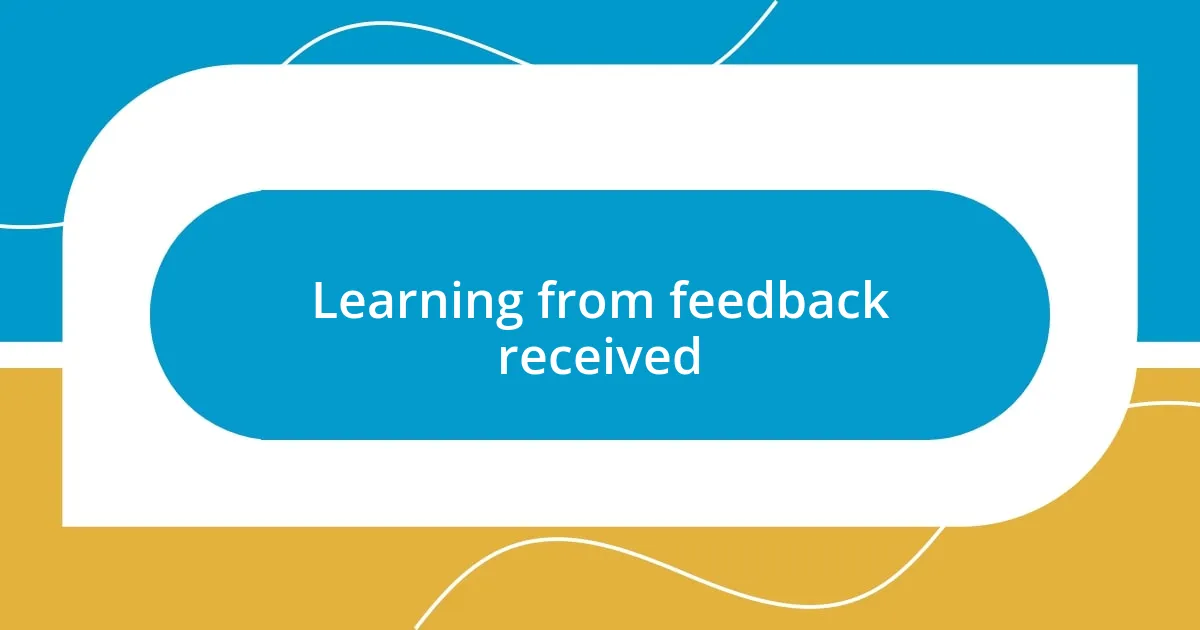Key takeaways:
- Art becomes a window into the artist’s soul, revealing internal struggles and emotions.
- Overcoming technical and logistical challenges during preparation is vital for building resilience and refining the artistic process.
- Engaging with the audience fosters a collaborative experience, enhancing the emotional impact of the artwork.
- Feedback from viewers is invaluable, serving as a guide for artistic growth and future projects.

Understanding my artistic vision
Understanding my artistic vision became a journey of self-discovery. I remember standing in front of my own work on exhibit night, surprised by how much each photograph reflected my internal struggles and dreams. Have you ever felt a sense of clarity from something you created? That night, it hit me—every image wasn’t just a visual story; it was a window into my soul.
Realizing that my vision was shaped by my experiences brought an emotional weight to each piece. I had a photograph that captured a fleeting moment during a rainy afternoon, where the light danced through the raindrops. It reminded me of the comfort I sought during tough times. In exploring these moments, I started contemplating how vulnerability can connect us with others. Isn’t it fascinating how art allows us to share what we often find hard to express verbally?
As I delved deeper into my artistic vision, I found it evolving beyond my initial ideas. I distinctly recall trying to convey happiness through stark contrasts in color, yet what emerged was a portrayal of melancholy intertwined with hope. It made me wonder—can we truly capture our emotions in a single frame? This realization sharpened my focus, guiding me to embrace the complexities of my feelings as I continue to refine my process.

Overcoming challenges during preparation
As I prepared for my first photo exhibit, the challenges seemed daunting. I remember encountering technical glitches during the editing process that left me feeling frustrated. Those late nights spent adjusting lighting and contrast often felt like a test of my patience. But overcoming those hurdles turned into a powerful lesson in resilience. Each fixed image brought a profound sense of accomplishment, reminding me that perseverance can truly shape artistic outcomes.
Another hurdle was deciding how to present my work. I thought, “How can I create an engaging space that captivates viewers?” After contemplating various layouts, I decided to create a narrative flow, guiding people through my story. The process required a lot of experimentation with spacing and lighting, but it ultimately transformed the feeling of the exhibit. What might seem like a minor detail made a significant impact—by curating the viewer’s experience, I was able to create an emotional connection, much like a thread weaving through the fabric of my images.
Ultimately, the time crunch was another challenge I faced. With only days left until opening night, I found myself paralyzed by doubt, wondering if I had enough pieces. However, I learned that sometimes less is more. By curating a smaller selection of my strongest works, I allowed each one to breathe and speak for itself, reinforcing the idea that quality trumps quantity. That experience taught me to trust my instincts and embrace the process, turning obstacles into stepping stones to artistic growth.
| Challenge | Overcoming Strategy |
|---|---|
| Technical glitches during editing | Perseverance and late-night troubleshooting |
| Exhibit layout and presentation | Experimentation with spacing and lighting |
| Time constraints | Curating a smaller, stronger selection of works |

Engaging with the audience effectively
Interacting with the audience during my exhibit was both thrilling and nerve-wracking. I remember stepping back from my display and watching people as they connected with my photographs. It was enlightening to see their eyes light up or reflect a sense of nostalgia. This prompted me to engage more actively, asking questions and welcoming their thoughts. Their responses not only enriched my understanding of each piece but also reminded me that art is truly a two-way street.
- I made sure to ask open-ended questions to spark deeper conversations.
- Creating a comfortable space allowed visitors to linger longer and share their reactions.
- Personally guiding some groups through my favorite pieces helped build a connection that made my story even more impactful.
Finding ways to genuinely engage with my audience transformed the entire experience into a collaborative exploration of emotions and narratives. I realized that every glance, every whispered comment, added another layer to the story I aimed to tell. It was a beautiful reminder that art is as much about the viewer’s interpretation as it is about the artist’s intention.

Marketing strategies for success
When it came to marketing my first photo exhibit, I quickly realized that personal connections could make all the difference. Instead of solely relying on social media posts or flyers, I reached out to friends, family, and local art enthusiasts directly. I crafted personalized invitations that not only showcased my work but also conveyed how much their support meant to me. This approach turned out to be invaluable; I noticed an increase in attendance simply because people felt personally invested in the event.
Leveraging online platforms also played a huge role in spreading the word. I invested time in creating a visually appealing website, complete with behind-the-scenes stories about my creative process. Sharing snippets of my journey on social media allowed my audience to become emotionally invested in the exhibit. I often wondered, how can I make them feel like part of my artistic journey? Turns out, by providing a glimpse into my experiences and struggles, I formed a bond that motivated them to come see my work firsthand.
Lastly, collaborating with local businesses amplified my reach. I approached a nearby café to feature a few of my photos on their walls leading up to my exhibit. This partnership not only provided an extra platform for display but also attracted their loyal customers, many of whom became attendees. Seeing my art in a beloved local spot made the experience feel more grounded in community, reminding me that creativity flourishes in shared spaces. Isn’t it fascinating how marketing can be as artistic as the exhibits themselves?

Learning from feedback received
Receiving feedback after my first photo exhibit was like opening a treasure chest filled with insights. I vividly recall a moment when a visitor shared how one of my photographs reminded them of a family trip. This sentiment struck a chord with me, as it made me realize that my work resonated with their personal experiences. In retrospect, I can see that such moments of connection are what make art truly powerful.
The comments I received were a mix of praise and constructive criticism. Initially, it stung to hear suggestions for improvement, but the reality hit me: this feedback was golden. One particular piece I had hoped would garner admiration got some unexpected critiques about its composition. At first, I was defensive, but later, I appreciated the perspectives shared. It pushed me to reassess my creative choices and consider how I could evolve as an artist.
Reflecting on this feedback has been a rewarding process. I found myself jotting down notes after conversations, almost like a journal of lessons learned. The experience made me ponder: how often do we let the perspectives of others enhance our own journeys? Embracing these insights not only brought clarity to my future projects but also deepened my connection with my audience. Ultimately, their voices became a guiding force, nudging me toward artistic growth in ways I never anticipated.

Planning for future exhibitions
As I think about planning future exhibitions, I realize that setting clear goals is crucial. In my first experience, I was so focused on the art itself that I overlooked the importance of defining what I wanted to achieve. Did I want to sell pieces, gain exposure, or simply create a memorable experience for attendees? By outlining my objectives from the start, I can align my creative vision with practical outcomes, giving each exhibition a more focused direction.
I’ve also found that the logistics can make or break the experience. The layout of my first exhibit felt somewhat haphazard, which meant visitors sometimes missed the message I intended to convey. Through this experience, I learned to envision the flow of the space and how it guides interaction. A well-thought-out arrangement not only enhances the aesthetic but also leads to a more meaningful engagement. I’ve asked myself: How does each piece relate to the next? Recognizing these connections transformed my approach to curation.
Finally, I believe that building a supportive team is essential. During my first event, I relied heavily on myself, but I quickly learned the benefit of surrounding myself with passionate individuals who share a vision. Whether it’s a friend helping with setup or a fellow artist providing moral support, collaboration enriches the overall experience. Ultimately, I think about what roles and responsibilities will facilitate a smoother event. Isn’t it fascinating how, in art as in life, the right partnerships can elevate our work to new heights?














